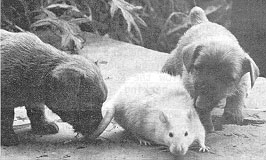
Articles Index/Earthdog
Revised 04/21/02
Very young Norfolk puppies -- five weeks and up --- can start their "field" training right in the house! To begin, cut doorways in the opposite ends of a cardboard box and lay it on the floor, bottom side up. Pups will use this fascinating "toy" to play in and out of and will thus become accustomed to dark spaces and small openings.
A galvanized stove pipe, 8 to 10 inches in diameter, can be hidden behind a couch and additional tunnels can be built by taping cardboard boxes together. Old socks with knots in them can be left in the cage of pet rats and mice until they've thoroughly absorbed the scent of the rodents. Then, they can be used as toys for the puppies who will play at "killing" them.
At 8 to 12 weeks, as pups get stronger and are outside more, you can add to your backyard:
Pups will play together, along with their elders, running in and out of the tunnels.
Be very sure that all tunnels have daylight at the end so that puppies will not feel trapped and become scared. They must know they can get out easily. After all, no smart little Norfolk is going to go into a hole that she knows she can't get out of. That's survival!
If you live in an area where you can hunt your adult Norfolks, take the puppies along to romp in the woods and fields. As the adults dig up mice, investigate woodpiles, fallen trees and woodchuck dens, the pups will follow right along ... sniffing, digging, getting excited and "helping" the big dogs do their thing. And, they will be learning.
Always start pups with adults that know what to do. It's the easiest way to train youngsters and they will feel safe with mom and pop and other adult Norfolks telling them what to do.

The pet rat in this picture is Tammy. She trained many pups until her natural death at the age of three. Pet rats are very smart. Treated gently, they learn to accept the dogs and do not become frightened. They will even sit in their cage at the end of the tunnel, grooming themselves, while the pups scream and scramble at the cage.
Before teaching your Norfolk to hunt and kill unwanted varmints, decide on two different commands. A command to hunt and kill, given in a high, excited voice ("sic 'em", "get it"), is used only when you want the dog to hunt seriously.
A command to be used around small household animals such as tiny kittens, hamsters, gerbils, rabbits, etc. should be delivered in a firm, low, quiet voice. Teaching your puppies to "Be good" or "Be gentle" is important from the very beginning if they are to socialize with your other household "critters." Once in a while, a sharp rap in the hindquarters and a loud "NO!" may be necessary if the youngster shows any aggressive signs while under this command.
Continue using the two different commands for the two types of behavior throughout the dog's life. Remember to reward each type of correct behavior with praise and love.
Most Norfolks have enough common sense and "holding power" to learn the difference between commands without difficulty.
Keeping one or two adult pet rats that have been handled a lot is a good way to teach the pups to follow a rat scent. The pet rat can go through a tunnel, leaving a trail. The rat is then put in a small cage that fits at the end of the tunnel. Pups are then turned loose to enter the tunnel and follow the scent. They "work" their quarry by barking, growling, digging and so on. In this way, they learn to go to ground and work their prey without harm coming to anyone. This is a good training procedure for people who do not want their Norfolk to kill anything, ever. And, this behavior is all that is needed to compete in American Working Terrier Association trials and earn a Certificate of Gameness.
If you allow your Norfolk to hunt "for real", make sure they have all their vaccinations, including leptospirosis.
For further information, [see] Pat Lent's book Sport With Terriers, Arner Publications.
Carolyn Pyle
ANTIC, Spring 1983 & March 2002
Back to Articles Index
Back to Home Page